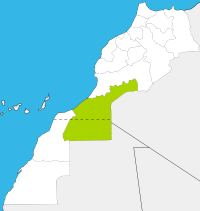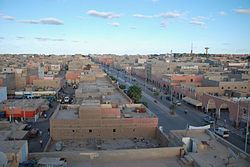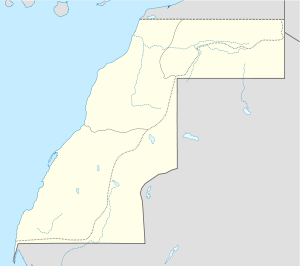- Smara
-
Smara
السمارةLocation in Morocco Coordinates: 26°44′22″N 11°40′13″W / 26.73944°N 11.67028°W Country Western Sahara Claimed by Morocco, Sahrawi Arab Democratic Republic Controlled by Morocco Population (2006) – Total 42,056 Smara, also Semara (Arabic: السمارة), is a city in the Moroccan-Administered Western Sahara, with a population estimated at 42,056.[1]
Contents
History
The largest city in its province, Smara was founded in the Saguia el-Hamra as an oasis for travellers in 1869. It is the only major city in Western Sahara that was not founded by the Spanish. In the center of the city the remains of a stone fortress can be found, the Zawiy Maalainin, which enclosed a mosque. The Maalainin lived there from 1830 until 1912. It was made a capital and religious center in 1902 by shaykh Ma al-'Aynayn, in what was then Spanish Sahara. The location of the city was intended to ensure its becoming a caravan trade hub in the sparsely populated Sahara desert. The enlargement of Smara was carried out by local Sahrawis as well as craftsmen sent by the sultan Hassan I. In 1902, shaykh Ma al-'Aynayn moved to Smara and declared it his holy capital. Among other things, he created here an important Islamic library, and the town became a center of religious learning.
In 1904 the shaykh declared himself an imam and called for holy war (jihad) against French colonialism, which was increasingly pressing into the Sahara at this time. During the campaign against Ma al-'Aynayn, Smara was sacked almost completely in 1913 by the French Army, and its library destroyed.[2] The town was then handed over to the Spanish. In 1934 the town was once again destroyed after Sahrawi rebellions against the Spanish occupation.
The Vieuchange brothers
Reaching Ma el Ainain's mysterious Smara was the goal of the brothers Vieuchange, early 20th century French writers and romantics. Michel Vieuchange's painful journey through the rebel-held Sahrawi lands in 1930 disguised as a Berber tribeswoman, eventually reaching Smara on 1 November 1930, and the illness that lead to his death on the return, is documented in his journals.[3] Comprising seven notebooks and more than 200 photographs, the account was published posthumously in 1932 as Smara: The Forbidden City (1932) by his brother Jean and became a bestseller.
After 1975
In 1975, Morocco took control of Saguia Elhamra as Spain withdrew, according to the Madrid Accords. The Moroccan army took the city from the Polisario Front in 1976. Near Tindouf, Algeria, there still exists a Sahrawi refugee camp named after Smara. It is one of the four camps of the SADR administration in Algeria.[4]
The town is presently controlled by the Moroccan authorities, as part of what the government terms its Southern Provinces, and enclosed by a section of the Moroccan Wall.
Notes and sources
- Notes
- ^ Stefan Helders (2006). "Western Sahara - largest cities (per geographical entity)" (in English). World Gazetteer. http://www.world-gazetteer.com/wg.php?x=&lng=de&dat=32&geo=-70&srt=npan&col=aohdq&men=gcis&lng=en. Retrieved 2006-08-24.
- ^ After a defeat of the French at Lebeyratt colonel Mouret mounts an attack against Smara. Leaving from Teyarett (in the north-west of Atar) on the 9th of february, he arrives in the Zemmour on the first of march to sack the holy city (Smara). He finds her empty of all people.(Le Rumeur (Guy) : Le Grand Méhariste, Paris, Berger Levrault)
- ^ Vieuchange (1988), pp. 2–3.
- ^ According to the American Refugee Committee (ARC), approximately 39,000 Sahrawi refugees live in Asward camp, which is some 20 miles (30km) from Tindouf; some 38,000 live in Dakhla camp, the furthest at about 110 miles (180 km) from Tindouf; an estimated 39,000 refugees live in Laayoune camp, about 5 miles (10 km) from Tindouf; and more than 39,000 Sahrawi refugees live in Smara camp, which is about 30 miles (50 km) from Tindouf. The number of refugees in the camps has, according to ARC, quadrupled since 1979.
- Sources
- Vieuchange, Michel (1988) [1932]. Smara: The Forbidden City. Fletcher Allen, Edgar (translation); Vieuchange, Jean (editor; introduction, notes, postscript); Claudel, Paul (preface). (Reprinted ed.). New York: Ecco. ISBN 978-0880011464.
External links
- Entry in Lexicorient
- ad for "Smara: The Forbidden City" by Jean and Michel Vieuchange (ISBN 0-88001-146-7)
- Satellite view in Google Maps
Coordinates: 26°44′22″N 11°40′13″W / 26.73944°N 11.67028°W
 Guelmim-Es Semara regionCapital: Guelmim
Guelmim-Es Semara regionCapital: GuelmimProvinces Assa-Zag Province · Smara province · Guelmim Province · Tan-Tan Province · Tata Province
Cities Categories:- Populated places in Western Sahara
- Guelmim-Es Semara Region
Wikimedia Foundation. 2010.


